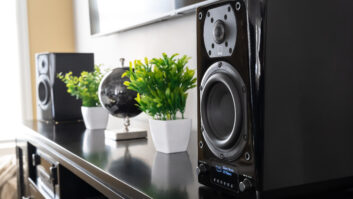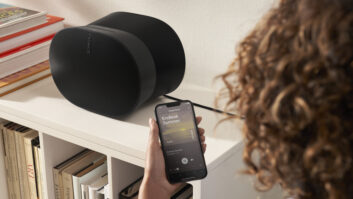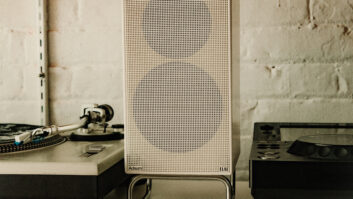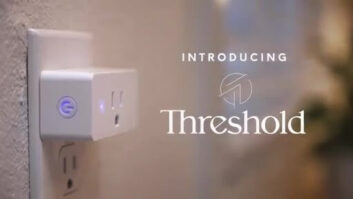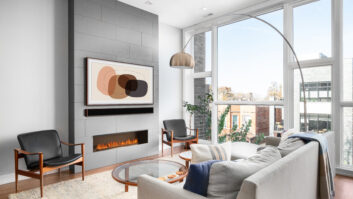Kudos: MartinLogan’s new Motion 4i and Motion 8i speakers improve upon the originals in nearly every way, with a slicker form factor, upgraded sonics, and the same distortion-free, highly dynamic sound.
Concerns: As with the originals, though, these speakers want to be played at or near reference listening levels, which may make them less than ideal for clients who want to keep the volume low.
MartinLogan’s Motion Series speakers were something of a revolution when they first hit the market in 2010. They broke with tradition not only in terms of pricing, but also in terms of just how much speaker you could get in such a little package. And that’s not even mentioning the fact that their form factor eschewed the boxy look typically associated with low-cost, compact speaker systems. Say what you will about the sort of melty aesthetic of the original Motion line, but at least they weren’t boring.

That was then, though, and this is now. And in the eight years since, a number of manufacturers have stepped up their games in terms of just how much speaker you can get in such compact size for such little money. Focal comes to mind, with its Dôme Flax system. Bowers & Wilkins, too, with its MT-60D system. And, of course, GoldenEar Technology dropped its SuperSat system onto the market not long after the release of the Motion Series, relying on a very similar folded tweeter technology and much the same value proposition.
Also reviewed by Dennis Burger: Meridian Audio’s 857 Reference Two-Channel Power Amplifier
Look, I’m not saying that MartinLogan had no choice but to update the Motion Series, exactly; I’m merely saying that it was a very good idea. So, you may be asking, what exactly are these new upgrades? In addition to hanging a lower-case “i” onto the ends of the model names, MartinLogan has given its Motion Series speakers a pretty striking (but in many ways subtle) aesthetic makeover, which mostly boils down to sharpening the lines, giving the speakers a crisper, sexier, more modern look.
It doesn’t sound like much, but one only needs to plop an old Motion 4 next to a new Motion 4i to see how effective these little tweaks are. The new speaker looks more refined, classier, better suited to swankier rooms. It’s undeniably a child of the Apple Era of Product Design.
Under the hood, the new speakers also benefit from reworked crossovers, and the smaller Motion 2i and 6i, which I didn’t bring in for review, also feature somewhat smaller, 0.94- × 1-inch Folded Motion tweeters. The 4i and 8i reviewed here still rock a tweeter with a 1- × 1.4-inch footprint and 5.25- × 1.75-inch total surface area.

You’ll also notice that the Motion 4i ($249.95) and 8i ($399.95) sport upgraded binding posts, which ditch the rubber plugs in the end and go for a somewhat more traditional look. They’re still spring-loaded, and if you’re relying on a bare-wire connection, there’s still a nice wire channel in the back that hides the connection, making it look like your cables disappear into the cabinet. The channel is much thinner this time around, though, which helps with the looks, but hinders quick hookup a bit. In the end, aesthetics be damned, I opted for banana plug connections all the way ‘round.
Yeah, but like…how do they sound?
If you’re familiar with the performance of the older Motion Series speakers, there won’t be any revelations in the following paragraphs. But at the risk of sounding like a broken record: they sound a lot like their older siblings, just more refined, more consistent, with a better transition between midrange and treble, and improved off-axis performance.
If you’re not familiar with the original Motion Series speakers, their performance can best be summed up in two words: “detailed” and “dynamic.” Much like the originals, the amount of sound coming out of these little cabinets is a bit startling. Yes, they’re somewhat power hungry, so I wouldn’t try running them off a 60-watt-per-channel AV receiver or anything. But give them the juice and they run with it, cranking out some truly ferocious sound and begging for more. For the duration of this review, I relied on an Anthem MRX 710 for power and room correction, and found it to be a match made in audio heaven.
Also reviewed by Dennis Burger: Yamaha R-N803 Network Stereo Receiver
I fed the system – comprised of two Motion 4i speakers up front and in the rear, and a Motion 8i front and center, mated with an RSL Speedwoofer 10S sub to complete the 5.1 setup – a few of the most raucous clips from Star Wars Episode VIII: The Last Jedi, and the harder I cranked the system, the harder the MartinLogans sang.
The flipside to that? The quieter I played them, the less the Motion Series speakers really set themselves apart from more traditional compact speakers. These puppies want to bark, and they want to bark loudly, so they might not be right for the client who keeps the volume knob turned to the left and insists upon leaving Night Mode engaged on his or her receiver no matter the time of day.
They also might not be the right speaker system for couples with young kids, unless you plan on wall mounting them. I say that because the new Motion Series speakers collect fingerprints the way Hannibal Lecter collects human sweetbreads. And say what you will about Lecter, but at least he cleaned up after himself. In the few weeks I spent with this new MartinLogan system, I had to hit the speakers with Lemon Pledge and a damp cloth at least a couple times a week.
On the upside, though, hanging these speakers from the wall, even high up and out of the way of wandering fingers, doesn’t represent a significant sonic compromise thanks to their excellent vertical (as well as horizontal) dispersion. They’re way more forgiving in terms of placement than they have any right to be. Just for kicks, I wall-mounted the front right and rear left speakers, leaving their opposites down low on my credenza and bookshelf – an arrangement that should have resulted in a cockeyed, wibbly-wobbly soundfield, but instead gave me very nearly the same holographic bubble of sound as when all speakers were installed on the same listening plane at ear level.
Contact information: 785.749.0133, martinlogan.com
Product Specs
Motion 4i
- Frequency Response: 70–23,000 Hz ±3dB
- Horizontal Dispersion: 80 degrees
- Vertical Dispersion: 80 degrees
- High Frequency Transducer: 1- × 1.4-inch (2.6cm × 3.6cm) Folded Motion Transducer with 5.2- × 1.75-inch (13.3cm × 4.4cm) diaphragm
- Low Frequency Transducer: 4-inch (10.2cm) paper cone with stamped steel basket. Non-resonant asymmetrical chamber format. Rigid structured dust cap to reduce cone break-up modes. Folded bass reflex port.
- Sensitivity: 90 dB/2.83 volts/meter
- Impedance: 4 Ohms Compatible with 4, 6, or 8 Ohm rated amplifiers.
- Recommended Amplifier Power: 20–150 watts per channel
- Crossover Frequency: 2900 Hz
- Components: Custom air core coil and low DCR steel laminate inductors; polyester film capacitors in series and low DF electrolytic capacitors in parallel; overall system thermal/current protection.
- Inputs: Push style with banana jacks
- Weight: 6 lbs. (2.72 kg)
- Dimensions: 12.6 inches x 5.6 inches x 5.7 inches (32cm x 14.3cm x 14.5cm)
Motion 8i
- Frequency Response: 70–23,000 Hz ±3dB
- Horizontal Dispersion: 80 degrees
- Vertical Dispersion: 80 degrees
- High Frequency Transducer: 1- × 1.4-inch (2.6cm × 3.6cm) Folded Motion Transducer with 5.25- × 1.75-inch (13.3cm × 4.4cm) diaphragm
- Low Frequency Transducer: Two 4-inch (10.2cm) paper cone with stamped steel basket; non-resonant asymmetrical chamber format; rigid structured dust cap to reduce cone break-up modes; sealed.
- Sensitivity: 89 dB/2.83 volts/meter
- Impedance: 4 Ohms Compatible with 4-, 6-, or 8-Ohm rated amplifiers.
- Recommended Amplifier Power: 20–180 watts per channel
- Crossover Frequency: 3000 Hz
- Components: Custom air core coil and low DCR steel laminate inductors; polyester film capacitors in series and low DF electrolytic capacitors in parallel; overall system thermal/current protection.
- Inputs: Push style with banana jacks
- Weight: 8.5 lbs. (3.85 kg)
- Dimensions: 5.6 inches x 22.25 inches x 5.2 inches (14.2cm x 56cm x 13.2cm)

